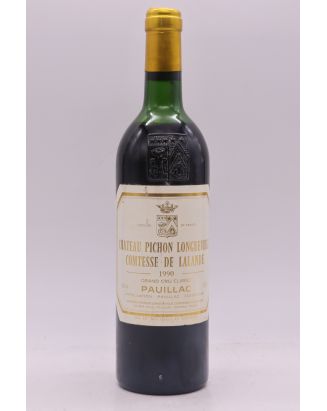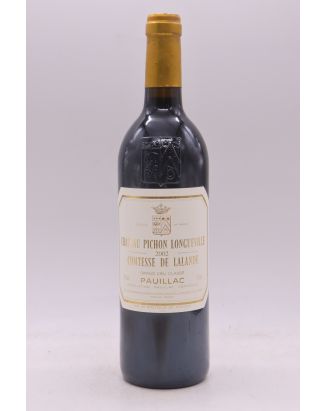











The history of Château Pichon Longueville Comtesse de Lalande begins in the late 17th century with Pierre Desmezures de Rauzan, a merchant and manager of the prestigious Latour and Margaux estates. In 1689, he purchased vineyards located near Château Latour, forming the heart of the future Pichon Longueville estate. A few years later, when his daughter Thérèse married Jacques de Pichon, Baron of Longueville, the vineyards became a dowry, thus laying the foundations of the wine estate.
In 1850, just before his death, Baron Joseph de Pichon Longueville divided the property among his children. Two-fifths of the estate were given to his sons, giving birth to Pichon Baron, while the remaining three-fifths went to his daughters, marking the birth of Château Pichon Longueville Comtesse de Lalande. The estate takes its name from one of these heiresses, Virginie Pichon, Countess of Lalande, who built the château and worked for the wine's reputation.
The château then passed through several hands before being acquired in 1925 by the Miailhe brothers, Louis and Édouard, wine brokers. They restored the estate's lost luster, and their descendant, May-Eliane de Lencquesaing, propelled Château Pichon Comtesse onto the international stage from 1978 onwards. In 2007, the Rouzaud family, owners of the Champagne house Louis Roederer, purchased the estate and continued its ascent to excellence, under the direction of Nicolas Glumineau since 2012.
Château Pichon Longueville Comtesse is distinguished by high scores from Robert Parker, with 100/100 for the 1982, 2016 and 98/100 in 2019 , confirming its reputation among the great growths of Pauillac.
The terroir of Château Pichon Longueville Comtesse de Lalande is a key element in the expression of its wines. Located between the Atlantic Ocean and the Gironde estuary, in the south of the Pauillac appellation, on the left bank, the vineyard covers an area of 102 hectares. It is distinguished by soils consisting of gravel ridges on clay, resulting from the retreat of waters during the Quaternary period. These poor and well-draining soils offer ideal conditions for vine cultivation, allowing optimal grape ripening and perfect terroir expression.
A notable feature is that 11 hectares of vines are located in the neighboring commune of Saint-Julien, giving the wines of Château Pichon Comtesse a unique dimension. The vines, with an average age of 35 years, are planted at a density of 9,100 vines per hectare, ensuring exceptional concentration of aromas and flavors.
The grape varieties are dominated by Cabernet Sauvignon (64%), which brings structure and depth to the wines. It is complemented by Merlot (27%), which contributes roundness and suppleness, as well as more minor varieties such as Cabernet Franc (6%) and Petit Verdot (3%), which add touches of complexity and spice. The vineyard has been undergoing conversion to organic agriculture since 2021, affirming the estate's commitment to increased respect for the environment and sustainable viticulture.
Vinification at Château Pichon Longueville Comtesse de Lalande is part of a meticulous and innovative approach, aimed at extracting the best from the terroir while respecting the integrity of the grapes. Since 2013, the estate has been equipped with an ultra-modern vat room, composed of 63 vats, allowing precise plot-by-plot vinification. This system offers the possibility of treating each vineyard plot separately, thus preserving the authenticity of the different terroir expressions.
One of the innovative aspects of the vinification is the use of gravity to handle the grapes, must, and wine, avoiding any pumping that could alter the quality of the final product. After alcoholic fermentation, malolactic fermentation takes place in vats before the wine is put into barrels for aging.
The grand vin of Château Pichon Longueville Comtesse de Lalande is aged for 18 months in French oak barrels, 50% of which are new and 50% one year old. This wood aging process, combined with medium toasting of the barrels, gives the wines subtle aromas of vanilla and spices, while preserving the freshness and purity of the fruit.
Grand Vin: Château Pichon Longueville Comtesse de Lalande
The estate's grand vin, Château Pichon Longueville Comtesse de Lalande, is the ultimate expression of finesse and complexity. Composed mainly of Cabernet Sauvignon, this wine is distinguished by its depth, silky tannins, and exceptional aging potential. It is often described as sensual, with notes of ripe fruit, tobacco, and earth. This wine improves admirably with age, revealing increasingly complex aromas over time.
Second Wine: Réserve de la Comtesse
Réserve de la Comtesse, the estate's second wine, is produced from the youngest plots of the vineyard. Less structured than the grand vin, it is nonetheless elegant and accessible from its youth. With fine tannins and a more relaxed palate, it represents an excellent introduction to the estate's style, while offering immediate pleasure.
Third Wine: Les Gartieux de Pichon Lalande
Produced in limited quantities, Les Gartieux de Pichon Lalande is the estate's third wine. This wine is made from grapes from young vines and specific plots. It reflects the estate's know-how while being more financially accessible. It's a wine to be enjoyed earlier, but still retains the quality imprint of the Pauillac terroir.
Experimental White Wine
In 2022, the estate launched an ambitious project with the production of an experimental white wine, made from a blend of Chardonnay and Savagnin. This wine is vinified in glass amphorae, thus preserving all the purity of the aromas. This project reflects the innovative spirit of Château Pichon Longueville Comtesse de Lalande and its constant desire to explore new paths while remaining true to its terroir.
Pauillac, one of the most prestigious appellations in the Médoc, ranks among the great Bordeaux wines, with remarkable vintages that have made history. Among the finest vintages are those from 1975, 1982, 1985, 1986, 1989 and 1990, renowned for their complexity and longevity. The years 1995, 1996, 2000, 2003 and 2005 also stand out for their richness and power. More recently, the vintages 2008, 2009, 2010, 2012, 2014, 2015, 2016, 2017, 2018, 2019 and 2020 have confirmed Pauillac's exceptional potential, offering wines that are both elegant and powerful, perfect for long-term cellaring.
The Second Growths of 1855 constitute a prestigious category, grouping together iconic estates that often rival the First Growths in quality. Among them, discover Château Brane-Cantenac and Château Durfort-Vivens, both located in Margaux, as well as Château Lascombes, Château Rauzan-Ségla, and Château Rauzan-Gassies. In Saint-Julien, wine enthusiasts will appreciate the wines from Château Ducru-Beaucaillou, Château Léoville Las Cases, Château Gruaud Larose, and the famous Château Léoville Poyferré and Château Léoville Barton. Don't miss Château Cos d'Estournel and Château Montrose in Saint-Estèphe, as well as the essential Château Pichon Longueville Baron and Château Pichon Longueville Comtesse de Lalande in Pauillac.
Château Pichon Longueville Comtesse de Lalande embodies the excellence of the great Pauillac growths. Thanks to an exceptional terroir, a rich history, and know-how passed down from generation to generation, this estate produces wines that stand out for their elegance, complexity, and aging potential. Whether through its grand vin, its Réserve, or its experimental cuvées, Château Pichon Comtesse continues to shine among the greatest names in the Médoc, seducing amateurs and connoisseurs around the world.